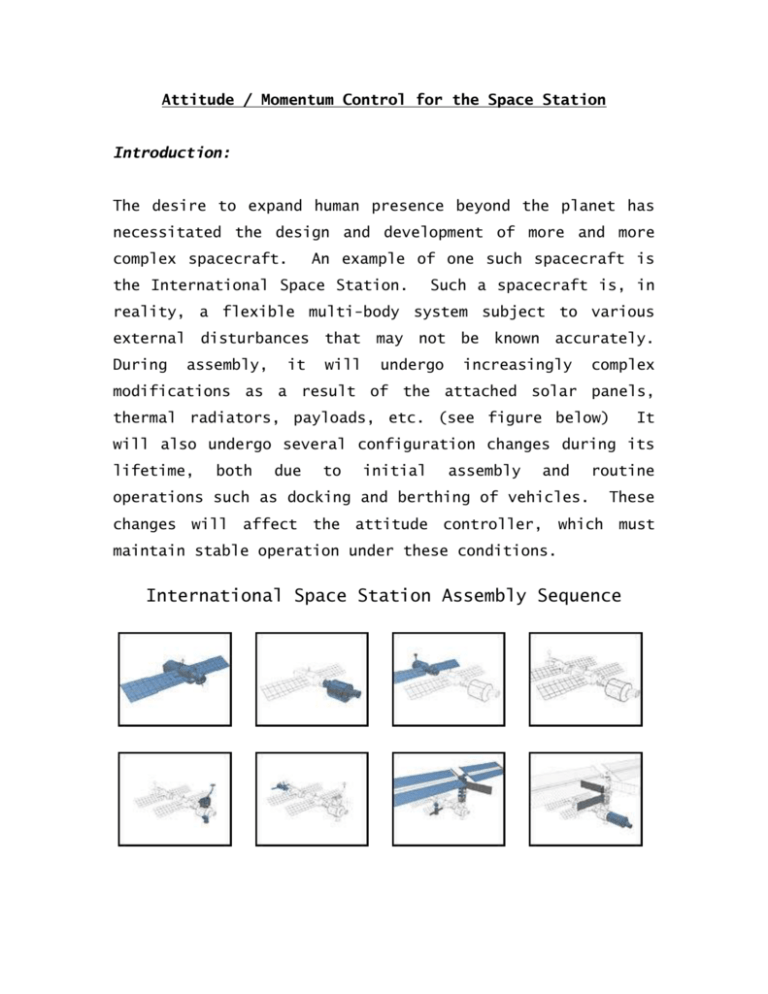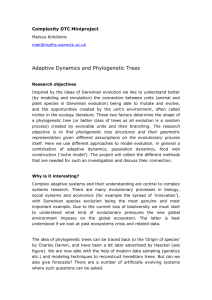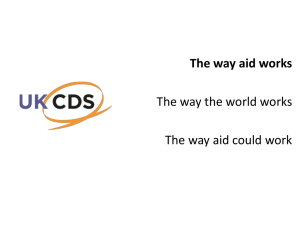Attitude / Momentum Control for the Space Station
advertisement

Attitude / Momentum Control for the Space Station
Introduction:
The desire to expand human presence beyond the planet has
necessitated the design and development of more and more
complex spacecraft.
An example of one such spacecraft is
the International Space Station.
Such a spacecraft is, in
reality, a flexible multi-body system subject to various
external
During
disturbances
assembly,
it
that
may
not
will
undergo
be
known
accurately.
increasingly
complex
modifications as a result of the attached solar panels,
thermal radiators, payloads, etc. (see figure below)
It
will also undergo several configuration changes during its
lifetime,
both
due
to
initial
assembly
and
routine
operations such as docking and berthing of vehicles.
changes
will
affect
the
attitude
controller,
which
These
must
maintain stable operation under these conditions.
International Space Station Assembly Sequence
A number of studies in the literature have presented the
tradeoffs
momentum
in
selecting
management
Researchers
have
the
various
techniques
investigated
attitude
control
appropriate
for
controllers
based
and
orbiting.
on
H ,
linear quadratic regulator and other robust methodologies.
Some have adaptive nonlinear approach to the problem. This
paper was done with an interest to apply what was learnt in
class,
simulate
methods
of
the
spacecraft
controlling
Specifically,
I
will
the
dynamics,
dynamics
derive
the
of
and
the
linearized
explore
spacecraft.
equations
of
motion of the Space Station, use them to model the system
in Laplace domain as well as state space, design PD and
Optimal
controllers,
and
implement
Parameter
identification/estimation and Adaptive Control.
Space Station Dynamics:
Assuming
single
rigid-body,
the
nonlinear
equations
of
motion for the spacecraft with body-fixed control axes can
be expressed by Euler’s equations of motion, given by:
h h T
Where
h I
is
the
angular
inertia matrix, and
momentum
vector,
I
is
the
is the angular velocity vector of
the spacecraft. is given in the intertial axes, Êi , where
as the body co-ordinates are êi ; these axes are related by:
eˆi R() R( ) R( ) Eˆi .
R ( ) ,
pitch
R ( ) ,
( )
R ( ) , are rotation matrices in the yaw
and roll
( )
directions respectively.
( ) ,
The net
torque on the spacecraft due to the gravity gradient can be
written as:
Tgg
3
rˆc I rˆc .
rc3
where rc is a vector from the center of the earth to the
center of mass of the Space Station.
Thus, the net torque
about the space craft center of mass can be decomposed into
gravity gradient, disturbance and control torques:
Ttotal =
Tgg+w(t)-u(t), where u(t) is the control torque and w(t) is
the net disturbance torque.
Rewriting the Euler equation:
h h Tgg w(t ) u (t )
This can be written as:
I11
I
21
I 31
I12
I 22
I 32
I13 1
0
I 23 2 3
2
I 33 3
3
0
1
2 I11
1 I 21
0 I 31
I12
I 22
I 32
I13 1
0
2
I 23 2 3n c3
c2
I 33 3
c3
c2 I11
c1 I 21
0 I 31
0
c1
I12
I 22
I 32
I13 c1 u1 w1
I 23 c2 u2 w2
I 33 c3 u3 w3
where
c1 = -sin2 cos3
c2 = cos1 sin2 sin3 + sin1 cos2
c3 = - sin1 sin2 sin3
+ cos1 cos2
Attitude kinematics for the 2-3-1 bocy-axis sequence gives:
1 n 3 1
2 n 2
3 n 1 3
Using
the
small
angle
approximation,
the
equations
motion can be reduced to:
I 1 1 4n 2 ( I 2 I 3 ) 1 n( I 1 I 2 I 3 ) 3 u1 w1
I 2 2 3n 2 ( I1 I 3 ) 2 u2 w2
of
I 3 3 n 2 ( I 2 I 1 ) 3 n( I 1 I 2 I 3 ) 1 u 3 w3
The disturbance modeled is a bias plus a cyclic component
at the orbital rate caused by the Earth’s diurnal bulge:
w(t ) Bias A sin( nt )
Control:
The linearized equations of motion above can be written as
follows using laplace variables:
1 ( s )
1
( s 3 u1 w1 )
s 4n ( I 2 I 3 )
2
1
(u2 w2 )
s 3n ( I1 I 3 )
2 (s)
3 ( s)
2
2
2
1
( s1 u3 w3 )
s n ( I 2 I1 )
2
2
The system can be written in 6-dimensional state space as:
0
x 1
x 2 4.61 *10 6
0
x3
x
0
4
0
x5
0
x 6
1
0
0
0
0
0
0
0
0
0
0
0
2.786 *10 6
0
1
0
0
0
0
0
0.00184
0
0 8.156 *10 7
0 x1
0
0.00215 x 2 1.99 *10 8
0 x3
0
0 x4
0
1 x5
0
0 x6
0
0
0
0
9.26 *10 8
0
0
u1 w1
0
u 2 w2
0
u w
3
3
0
1.71 *10 8
The numbers in the above matrices were calculated using the
following values for the Space Station inertias (slug-ft2):
Ioo=50.28*106
I22=10.80*106
I33=58.57*106
Iij,(ij)=0
The aerodynamic torque (ft-lb) is given by
w1 = 1+sin(nt)
w2 = 4+2sin(nt)
w3 = 1+sin(nt)
and n is the orbital rate of 0.0011 rad/s.
values used in references 1, 2, and 4.
These were the
It can be seen that
0
0
i = 0 is the unstable equilibrium of the system.
Any
disturbance or non-zero initial condition causes it to be
unstable.
Another system characteristic is that the pitch
axis is decoupled from the roll and yaw axes.
Therefore,
it is common practice to model the pitch axis dynamics
separately.
However, I have not done that.
PD control:
As a fist step in attitude control, a PD controller {u =
kd(de/dt)+kpe} was implemented for each of the 3 rotations.
This reduced the error in i significantly (see pages 1-2 in
Appendix).
State Feedback:
State feedback, u = -kx, was done to minimize the cost
function
J ( xT Qx u T Ru )dt .
Here
Q
and
R
were
identity
0
matrices
effort.
to
give
equal
weight
to
response
and
control
Results are shown on pages 3-4 of Appendix
For the same disturbance, a comparison of the states shows
that the PD controller has reduced the error in i better
than the Optimal Controller.
The control effort, on the
other hand, is slightly less in the case of the optimal
controller.
By varying the Q and R matrices in the cost
function or the gains in the PD controller, one can change
the outputs or inputs as desired.
I don’t see an advantage
of one controller over another for fixed and known plant
parameters.
Adaptive Control:
As was stated in the introductory part of the paper, the
International Space Station undergoes substantial mass and
configuration
Therefore,
changes
its
during
inertias
its
change
operational
considerably
lifetime.
during
the
assembly sequence and during nominal operations such as a
Space Shuttle docking and the movement of large payloads on
the mobile transporter.
above
cannot
The simple controllers presented
stabilize
the
variations in the inertias.
the
control
system
is
identification/estimation
Space
Station
for
large
One of the alternatives for
Adaptive
will
be
control.
an
Parameter
important
task
to
track the changes in the open-loop dynamics of the system.
Next,
I
have
Controller
and
tried
a
to
Self
use
Tuning
a
Model
Reference
Regulator
to
Adaptive
regulate
the
plant.
Parameter Identification:
Given the general system equations
x Ax Bu , where
x n
and A, B are unknown matrices, one can reparameterize as
follows:
matrix.
x Am x ( A Am ) x Bu , where Am is a known stable
The estimator equation is given by:
xˆ Am xˆ ( Aˆ Am ) x Bˆ u where Aˆ , Bˆ are estimates of A and B.
The
estimator error e = x - x̂ equation is e Am e ( Aˆ A) x ( Bˆ B)u .
Using
the
Candidate
~ ~
~ ~
~ ~
V (e, A, B ) eT Pe tr ( AT A) tr( B T B )
where
Lyapunov
function
~
~
A A Aˆ , B B Bˆ
and
analyzing its derivative, one can show that the Aˆ , Bˆ update
laws:
Aˆ PexT , Bˆ PeuT
V eT e 0 .
ensure a stable response:
This guarantees that the error goes to zero as time goes to
infinity.
Furthermore, given enough persistent excitation,
the estimations Aˆ , Bˆ converge to A, B.
Results are shown on
pages 5-6 of the appendix.
One of the initial assumptions in the above analysis is
that the plant is stable.
here.
not
Therefore,
applicable
However, that is not the case
parameter
to
this
estimation/identification
system
without
normalizing
is
the
signals.
One way to verify the parameter estimation algorithm is to
apply it to a known stable system.
was
to
run
feedback.
the
algorithm
on
Therefore, my next step
the
plant
with
optimal
This ensured bounded states, and results are
shown on pages 7-9 of the appendix. In this case, I have
initiated the system with non-zero initial conditions and
given disturbance with 3 different frequencies.
seen from the x and
zero,
and
there
matrices
as
well.
reflect
the
real
is
x̂
graphs,the error does converge to
parameter
However,
plant
As can be
at
convergence
this
parameters
point
because
on
the
Aˆ , Bˆ
it
does
not
the
loop
was
closed in order to ensure stability.
Another approach to the problem is to normalize the error
signal by enormalized =
e
.
100 x T x
Results using this technique
are presented on pages 10-12 of the appendix.
As can be
seen from the figure, the normalized error does converge to
zero, and some of the parameters (especially in the Amatrix) converge to constant values.
However, the number
of unknowns here is much greater than the number of PE
signals provided – therefore, not all the values in A and B
have converged to the A, B matrices.
The error does not
grow unbounded, however, I am limited in the amount of time
to
run
the
difficulties.
simulations
because
of
computational
Therefore, one can notice the convergence of
some of the elements in the A and B matrices.
MRAC:
The goal of Model Reference Adaptive Control is to control
the plant such that its response is similar to a stable
reference
model.
So
once
again,
x Ax Bu , and a reference model
given
the
x Am x Bm r , one
that the control, u = -k*x+l*r will do the job.
system,
assumes
Then one
goes through similar steps as earlier to obtain the update
laws:
kˆ ( BmT Pex T ) sgn( l*), lˆ ( BmT Per T ) sgn( l*) ,
estimates of k* and l*.
where
kˆ, lˆ
are
I tried implementing the MRAC
controller, but found out that the system is not minimum
phase – one of the requirements for MRAC.
Therefore the
plant did not follow the provided reference signal.
The
results show the plants states growing unbounded while the
reference state follows a constant.
Appendix.
See pages 13-14 of
Self Tuning Regulator:
I
have
also
attempted
a
self
tuning
regulator
on
the
system, using the parameter identification scheme, and an
optimal control:
U = B’Px.
See attachment 15.
However,
it was unable to stabilize the system, and I didn’t have
enough time to debug and continue with this controller.
Conclusions:
In my simulations, the PD controller was more effective
than the optimal controller in reducing the deviations in
the states due to the disturbances.
This might not be the
case if I had given more weight to the states than the
control
effort
in
the
cost
function.
Thus,
one
can
conclude that, for a known system, a PD controller of State
feedback will be sufficient to stabilize the system and
reduce i to stay within an acceptable range.
The Parameter Identification scheme showed me the effects
of
not
normalizing
the
signals.
It
was
successful
in
estimating some of the elements in the A and B matrices of
the system.
persistent
However, this system does not have enough
excitation
externally
elements in the A and B matrices.
to
identify
all
72
One way to over come
this problem is to rewrite the plant equations in such a
way that the three moments of inertias (the only unknowns)
will appear explicitly in the estimator. I’ve learned how
to design a Model Reference Adaptive Control, and also that
it is not applicable to this system since it is not minim
phased.
I tried to implement a self tuning regulator to
the
system,
controller.
but
did
not
have
enough
time
to
debug
the
This project has helped me see and understand
spacecraft dynamics better and know some of the problems
associated with control of spacecraft.
me
a
chance
to
try
my
hand
at
It has also given
several
of
the
control
algorithms discussed in class and given me a feel for the
responses to different controls, and the importance of the
assumptions
in
the
derivations
of
the
different
control
laws.
References:
1. R. H. Bishop, S. J. Paytner, J. W. Sunkel, “Adaptive
Control of Space Station with Control Moment Gyros”,
IEEE Control Systems Magazine, Oct1992, pg 23-27.
2. B. Wie, K. W. Byun, V. M. Warren, D. Geller, D. Long,
J. Sunkel, “New Approach to Attitude/Momentum Control
for the Space Station”, Journal of Guidance, Control
and Dynamics, Volume 12, sept.-oct.1989, pg 714-721.
3. A. G. Parlos, J. W. Sunkel, “Adaptive Attitude Control
and
Momentum
Management
for
Large-Angle
Spacecraft
Manuevers”, Journal of Guidance, Control and Dynamics,
Volume 15, Jul.-Aug.1992, pg 1018-1027.
4. S. Paytner, R. Bishop, “Adaptive Nonlinear Attitude
Control
and
Momentum
Management
of
Spacecraft”,
Journal of Guidance, Control and Dynamics, Volume 20,
sept.-oct.1997, pg 1025-1032.
5. J. Ahmed, V. T. Coppola, D. S. Bernstein, “Adaptive
Asymptotic Tracking of Spacecraft Attitude Motion with
Inertia Matrix Identification”, Journal of Guidance,
Control and Dynamics, Volume 21, sept.-oct.1998, pg
684-691.
6. S.
R.
Valadi,
H.
S.
Oh,
“Space
Station
Attitude
Control and Momentum Management: A Nonlinear Look”,
Journal of Guidance, Control and Dynamics, Volume 15
May-June 1992, pg 577-586.
7. L. Ehrenwald, M. Guelman, “Integrated Adaptive Cotrol
of Space Manipulators”, Journal of Guidance, Control
and Dynamics, Volume 21, Jan.-Feb.1998, pg 156-163.
8. J. Junkins, M. R. Akella, “Nonlinear Adaptive Control
of Spacecraft Maneuvers”, Journal of Guidance, Control
and Dynamics, Volume 20, Nov.-Dec.1997, pg 1104-1110.
9. L.
Shieh,
Regulators
H.Dib,B.
with
Mcinnis,
Eigenvalue
“Linear
Placement
in
Quadratic
a
Vertical
Strip”, IEEE transactions on Automatic Control, Vol
31, March 1986, pg 241-243,
10.
J.E. Slotine, W. Li, “Applied Nonlinear Control”
I don’t have the publisher information available at
this time.






